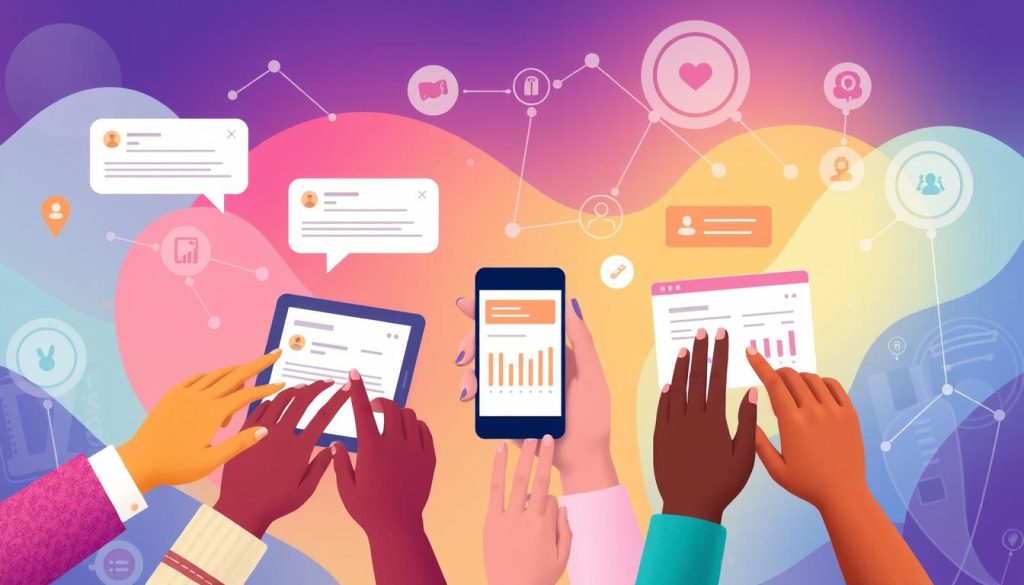Did you know that businesses with a strong focus on customer relationship management (CRM) see a 27% increase in profitability? This shows how important it is to master contact engagement, CRM scoring, and customer insights for your business.
In today’s competitive world, using data-driven strategies is key to success. This guide will give you the knowledge and tools to make the most of your contact engagement, CRM scoring, and customer insights. This will help you improve your CRM strategy, strengthen customer relationships, and increase conversions.
Key Takeaways
- Discover the importance of contact engagement and CRM scoring for driving business growth
- Learn how to effectively modify contact engagement scores for better customer insights
- Explore data-driven marketing strategies to leverage customer data and predictive analytics
- Understand the power of personalized communication and customer segmentation
- Uncover techniques for conversion optimization and holistic customer lifecycle management
- Leverage marketing automation to streamline processes and enhance customer engagement
- Gain actionable insights to transform your CRM strategy and drive business success
Understanding Contact Engagement and CRM Scoring
In the CRM world, knowing about contact engagement and CRM scoring is key. It helps businesses make smart choices and improve their marketing. Contact engagement shows how customers interact with your brand through website visits, emails, and social media.
What is Contact Engagement?
Contact engagement looks at how customers act towards your brand. It includes things like website visits, email opens, and social media likes. By tracking these, businesses learn more about their customers. This helps them make marketing plans that really work.
The Importance of CRM Scoring
CRM scoring is a tool that helps businesses focus on the best leads. It gives contacts scores based on how much they interact with your brand and other factors. This way, businesses can spot the most promising leads and use their resources wisely.
CRM scoring makes managing customer relationships easier. It helps businesses make smarter choices. This leads to better sales and happier customers.
| Metric | Description | Impact on CRM Scoring |
|---|---|---|
| Website Visits | The number of times a contact visits your website | More visits mean a stronger interest in what you offer, so a higher CRM score. |
| Email Engagement | The level of interaction with your email campaigns, such as open rates and click-through rates | Active email engagement shows a higher interest in your products, raising the CRM score. |
| Social Media Interactions | The level of engagement on your social media platforms, including likes, shares, and comments | Good social media engagement shows a strong connection with your brand, boosting the CRM score. |
Understanding contact engagement and CRM scoring gives businesses deep insights into customer behavior. This knowledge helps them improve their lead nurturing and customer management strategies.
How to Modify Contact Engagement Scores for Better Insights
Understanding your customers’ engagement with your business is key to success. By tweaking your contact engagement scores, you unlock valuable insights. These insights help improve your CRM and lead to better marketing strategies.
First, look at your current contact engagement scoring system. Check the metrics like email open rates, website visits, and social media interactions. Think about how these metrics help you understand your customers better. Then, see where you can make changes for better insights.
- Customize your engagement scores to fit your business needs. Give more importance to actions that show a strong chance of converting, like visiting your website several times or opening emails often.
- Use predictive analytics to guess what your customers might need. With lead scoring, focus on leads most likely to convert and use your resources wisely.
- Keep an eye on and tweak your contact engagement scoring often. Look at your data regularly, spot patterns, and adjust your system to capture the most useful customer insights.
Changing your contact engagement scores opens up a wealth of customer data. This data helps with CRM optimization and makes your marketing more targeted and data-driven. You’ll be able to offer a personalized experience that connects with your audience, boosting your business success.
“Modifying contact engagement scores is a game-changer for businesses that want to stay ahead of the curve and deliver exceptional customer experiences.”
Customer Insights: Unlocking the Key to Success
In today’s competitive world, knowing what customers want is key to growing your business. By understanding their needs and behaviors, you can improve your marketing and make it more personal. This helps you get better results.
Why Customer Insights Matter
Customer insights unlock your business’s true potential. Knowing your customers well lets you tailor your marketing to their needs. This way, you can make your marketing more effective and make decisions based on data.
- Enhance your customer segmentation and targeting efforts, ensuring you reach the right audience with the right message.
- Optimize your conversion optimization strategies, making it easier for customers to engage with your brand and complete desired actions.
- Foster deeper, more meaningful customer relationships through personalized communication and tailored experiences.
- Gain valuable insights into emerging trends and customer preferences to inform your data-driven marketing initiatives.
Understanding your customers helps you make better decisions and run more effective campaigns. This leads to sustainable growth for your business.
“The customer’s perception is your reality.” – Kate Zabriskie
By using customer insights, you can stay ahead in today’s fast-changing market. This is the key to long-term success.
Data-Driven Marketing: Leveraging Customer Data
In today’s fast-paced business world, data-driven marketing is a key player. It uses customer data to gain insights that help shape strategies. This leads to better communication and boosts business results.
This method relies on collecting, analyzing, and understanding customer data. By looking at what customers do online and what they buy, you can learn a lot about them. This helps you send messages that really speak to them and group customers in meaningful ways.
Using predictive analytics, marketers can guess what customers might want next. This lets them offer solutions that really hit the mark. This approach not only gets customers more involved but also increases sales and keeps them coming back.
“Data-driven marketing is no longer a luxury – it’s a necessity in today’s competitive business landscape. By harnessing the power of customer data, you can unlock a world of possibilities and propel your business to new heights.”
Let data-driven marketing change how you connect with your customers. By tapping into the power of customer data, you can take your business to new heights of success.

Predictive Analytics: Anticipating Customer Needs
In today’s fast-paced business world, predictive analytics is key for understanding what customers want. It uses advanced data analysis to see what customers like, what they might want next, and what they might do. This helps companies meet customer needs before they even ask.
The Role of Predictive Analytics
Predictive analytics is more than just looking at customer data. It helps businesses predict trends, spot risks, and make smart choices. By studying how customers act, score leads, and move through the customer journey, companies can plan their marketing better. This leads to happier customers and growth.
Techniques for Effective Predictive Analytics
To make the most of predictive analytics, companies need a good plan. Some top methods include:
- Machine learning algorithms that spot patterns in customer data
- Regression models that predict customer actions and sales trends
- Clustering algorithms that group customers by their traits
- Time series analysis to see when sales might go up or down
By using these advanced methods in their marketing and customer management, companies can meet customer needs early. This makes marketing more effective and helps them succeed over time.
“Predictive analytics is not about predicting the future, but about understanding the present — and using that understanding to shape the future.” – Eric Siegel, Predictive Analytics World
Personalized Communication: Building Lasting Relationships
In today’s competitive world, personalized communication is key to strong customer bonds. By knowing what your customers want and like, you can send messages that hit home. This approach boosts customer engagement, loyalty, and keeps them coming back.
At the core of this method is using customer info and data. By looking at what customers buy, how they browse, and who they are, companies get to know their customers well. This lets them offer customer experiences that meet each person’s needs. This builds customer loyalty and keeps customers around for the long haul.
Good personalized communication uses many strategies, such as:
- Personalized email campaigns that use the customer’s name and offer what they might like
- Custom product suggestions based on what they’ve bought before
- Web pages that change to fit what the user likes
- Targeted social media messages that talk directly to what the customer needs
Using data and focusing on the customer leads to stronger, more meaningful connections. This means better customer engagement, a better customer experience, and more customer loyalty and retention.

“Personalization is not just about using a customer’s name in an email; it’s about delivering a relevant, valuable experience that makes the customer feel understood and appreciated.”
Customer Segmentation: Targeting the Right Audience
In today’s market, knowing who your customers are is key. It helps you give them personalized experiences and reach the right people. By understanding what your customers like and need, you can make marketing that speaks to them. This leads to more people engaging with your brand and buying more.
Techniques for Effective Customer Segmentation
There are ways to split your customers into groups and learn more about them:
- Demographic Segmentation: Sort customers by age, gender, income, education, or where they live.
- Psychographic Segmentation: Put customers together based on their beliefs, interests, or how they live.
- Behavioral Segmentation: Look at how customers act, like what they buy, what they look at online, or how much they interact with your brand.
Using these methods together helps you get a clear picture of who your customers are. This lets you send messages that really speak to each group. Check out this link for more on how to connect with your audience.
| Segmentation Technique | Key Insights | Personalization Opportunities |
|---|---|---|
| Demographic | Age, gender, income, location | Tailored product recommendations, messaging, and offers |
| Psychographic | Interests, values, lifestyle | Personalized content, brand alignment, and customer experience |
| Behavioral | Purchasing habits, engagement levels | Targeted promotions, abandoned cart recovery, and customer loyalty programs |
By using these methods and data-driven marketing insights, you can send messages that really speak to your target audience. This approach helps you build strong relationships with your best customers.
“Effective customer segmentation is the foundation for delivering personalized experiences that build lasting relationships with your most valuable customers.”
Conversion Optimization: Maximizing Customer Engagement
In the fast-paced digital marketing world, conversion optimization is crucial for keeping customers engaged and helping businesses grow. By using data to guide their choices, companies can boost their conversion rates. This makes the customer experience better and turns leads into loyal customers.
Strategies for Conversion Optimization
A/B testing is a powerful way to improve conversion optimization. It involves testing different versions of web pages or marketing campaigns to see what works best. This method helps businesses refine their strategies for better results and more customer engagement.
Optimizing landing pages is also key to engaging customers. Making sure these pages look good, are easy to use, and meet the audience’s needs can greatly improve lead nurturing. This leads to more conversions.
Marketing automation is also vital for optimizing conversions. It automates tasks like sending emails, scoring leads, and delivering personalized content. This creates a smooth experience for customers, which increases customer engagement and conversions.
“Conversion optimization is not a one-time event, but a continuous process of testing, analyzing, and refining your marketing efforts to deliver the best possible customer experience.”
By using these strategies, businesses can make the most of their customer data. This leads to better engagement, more revenue, and strong relationships with customers.
Customer Lifecycle Management: A Holistic Approach
In today’s fast-changing business world, customer lifecycle management is key for lasting success. It’s about using data to manage every step of the customer’s journey. This way, businesses can learn a lot, build stronger bonds with customers, and grow steadily.
At the heart of good customer lifecycle management is knowing the various stages customers go through with your brand. From the first touch to keeping them coming back and making them loyal, each step offers chances to make the customer experience better and keep them engaged.
Using data-driven marketing, companies can understand what their customers want, like, and do. This knowledge lets them make their products better, improve how they connect with customers, and give them experiences that really speak to them.
“Successful customer lifecycle management is not just about acquiring new customers, but about nurturing and retaining them throughout their journey with your brand.”
To really get into customer lifecycle management, businesses should pay attention to these main parts:
- Seamless customer onboarding and engagement
- Personalized customer communication and building relationships
- Proactive customer retention and loyalty programs
- Continuous customer feedback and making things better
- Predictive customer insights and making decisions with data
By taking this full approach to managing the customer lifecycle, businesses can build a loyal customer base. This leads to steady growth in revenue and sets them up for success over the long term in a tough market.
Marketing Automation: Streamlining Processes
Discover how marketing automation can change your CRM strategy. It uses the latest technology to make your marketing better and engage customers more effectively. You can manage leads and talk to customers in a way that really connects with them.
Benefits of Marketing Automation
Marketing automation lets you use your customer data fully. It automates boring tasks, giving you more time for important work. You’ll see how data-driven marketing works wonders as you guide leads, send them personalized messages, and track your campaigns’ success.
Make your customers happier by adding marketing automation to your CRM. It makes managing leads easier and helps you understand what your customers like. This technology opens doors to building stronger customer bonds and keeping them loyal for a long time.
FAQ
What is Contact Engagement?
Contact engagement is how customers interact with your brand. This includes websites, social media, email, and in-person. It shows how well your marketing and customer service work.
Why is CRM Scoring Important?
CRM scoring helps you understand your customer relationships. It lets you focus on the best leads and tailor your messages. This makes your marketing and sales smarter.
How can I Modify Contact Engagement Scores for Better Insights?
To get better insights, adjust your contact engagement scores. Change how you weigh different factors. Look at customer behavior and add more data for a better score.
Why do Customer Insights Matter?
Customer insights are key for great CRM and marketing. They help you know what customers like and don’t like. This lets you make experiences that really connect with them.
How can I Leverage Customer Data for Data-Driven Marketing?
Using customer data makes your marketing smarter. Collect and analyze it to find important insights. This helps you make better marketing choices, like personal messages and customer groups.
What is the Role of Predictive Analytics in CRM?
Predictive analytics is vital for understanding customer needs. It uses machine learning to see what customers might do next. This helps you meet their needs before they ask.
How can I Deliver Personalized Communication to Build Lasting Relationships?
Personalized messages build strong customer bonds. Use customer data and insights to make messages that hit the mark. This builds loyalty and deep connections.
How can I Effectively Segment My Customer Base?
Segmenting customers right is key for personal touches. Use demographics and behavior to get to know your customers. This helps you target your marketing better.
What Strategies can I Use for Conversion Optimization?
Conversion optimization uses data to boost engagement and growth. Try A/B testing and landing page tweaks. These improve the customer experience and turn more leads into loyal customers.
How can I Adopt a Holistic Approach to Customer Lifecycle Management?
Understanding the customer journey is crucial for success. Know the stages from getting to know you to being a loyal fan. Use data to make experiences better at every step.
What are the Benefits of Marketing Automation?
Marketing automation changes the game by making things smoother and more engaging. It helps with lead management and making messages personal. This saves time for strategic growth and better customer insights.


